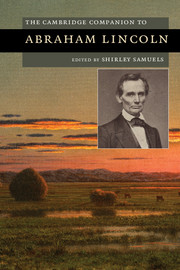Book contents
- Frontmatter
- Introduction
- 1 Rhetorically Lincoln: Abraham Lincoln and Oratorical Culture
- 2 Abraham Lincoln and Poetry
- 3 Seeing Lincoln: Visual Encounters
- 4 Lincoln's Gettysburg Address and Second Inaugural Address
- 5 Lincoln and the Natural Nation
- 6 Abraham Lincoln and the American Indians
- 7 Abraham Lincoln and the Self-Governing Constitution
- 8 Abraham Lincoln and Spiritual Crisis
- 9 America and Britain during the Civil War
- 10 Lincoln in International Memory
- 11 Lincoln's Hemispheric Relations
- 12 Lincoln on Hallowed Ground
- Guide to Further Reading
- Index
3 - Seeing Lincoln: Visual Encounters
Published online by Cambridge University Press: 28 September 2012
- Frontmatter
- Introduction
- 1 Rhetorically Lincoln: Abraham Lincoln and Oratorical Culture
- 2 Abraham Lincoln and Poetry
- 3 Seeing Lincoln: Visual Encounters
- 4 Lincoln's Gettysburg Address and Second Inaugural Address
- 5 Lincoln and the Natural Nation
- 6 Abraham Lincoln and the American Indians
- 7 Abraham Lincoln and the Self-Governing Constitution
- 8 Abraham Lincoln and Spiritual Crisis
- 9 America and Britain during the Civil War
- 10 Lincoln in International Memory
- 11 Lincoln's Hemispheric Relations
- 12 Lincoln on Hallowed Ground
- Guide to Further Reading
- Index
Summary
On January 18, 2009, Barack Obama delivered a brief but stirring address on the Washington Mall just two days before his historic inauguration as the forty-fourth president of the United States of America. The speech opened a widely viewed concert dubbed, “We Are One: The Obama Inaugural Celebration at the Lincoln Memorial”; Obama's already familiar eloquence established a celebratory tone for the celebrity performances that followed.
Yet, the setting of that speech was as rhetorically loaded as Obama's phrasing. The then president-elect stood at a podium on the steps of the memorial, directly in front of Daniel Chester French's iconic statue of Abraham Lincoln. Meticulously choreographed for the media, the staging afforded news cameras a dramatic photo op. From their vantage point, Obama appeared as a sober but vigorous figure emerging from the stately neo-Classical surroundings (Figure 1). Behind him, appearing almost as a spectral presence was the figure of Abraham Lincoln, his extended arms at once seeming to embrace Obama and offer the president-elect up to the American nation as Lincoln's political successor. Obama referenced and associated himself with Lincoln explicitly in his speech on that day, as he often did throughout the lengthy presidential campaign. He directed the audience to look at the memorial with its statue of Lincoln “… behind me, watching over the union he saved.”
- Type
- Chapter
- Information
- The Cambridge Companion to Abraham Lincoln , pp. 40 - 58Publisher: Cambridge University PressPrint publication year: 2012

